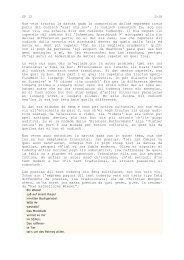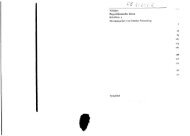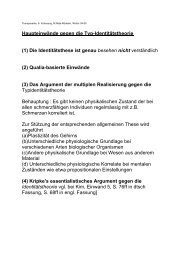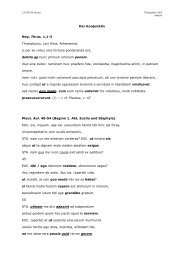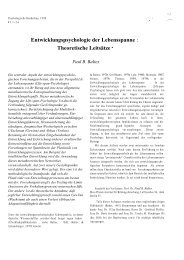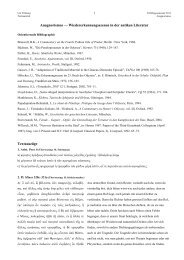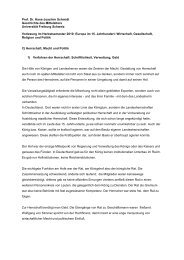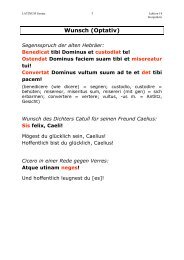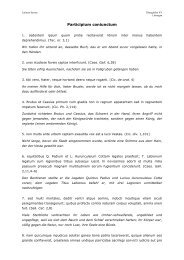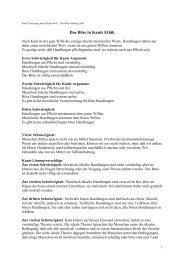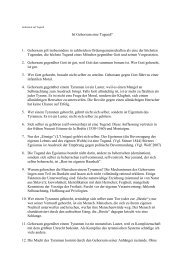Download - UniFr Web Access
Download - UniFr Web Access
Download - UniFr Web Access
Create successful ePaper yourself
Turn your PDF publications into a flip-book with our unique Google optimized e-Paper software.
"Stornei, Gru, Colombe": The Bird Images in Inferno V<br />
Author(s): Lawrence V. Ryan<br />
Reviewed work(s):<br />
Source: Dante Studies, with the Annual Report of the Dante Society, No. 94 (1976), pp. 25-45<br />
Published by: Dante Society of America<br />
Stable URL: http://www.jstor.org/stable/40166206 .<br />
<strong>Access</strong>ed: 06/12/2012 03:23<br />
Your use of the JSTOR archive indicates your acceptance of the Terms & Conditions of Use, available at .<br />
http://www.jstor.org/page/info/about/policies/terms.jsp<br />
.<br />
JSTOR is a not-for-profit service that helps scholars, researchers, and students discover, use, and build upon a wide range of<br />
content in a trusted digital archive. We use information technology and tools to increase productivity and facilitate new forms<br />
of scholarship. For more information about JSTOR, please contact support@jstor.org.<br />
.<br />
http://www.jstor.org<br />
Dante Society of America is collaborating with JSTOR to digitize, preserve and extend access to Dante Studies,<br />
with the Annual Report of the Dante Society.<br />
This content downloaded by the authorized user from 192.168.82.204 on Thu, 6 Dec 2012 03:23:25 AM<br />
All use subject to JSTOR Terms and Conditions
Stornei, Gru, Colombe:<br />
The Bird Images in Inferno v<br />
LAWRENCE V. RYAN<br />
often does modern criticism of Canto v of the Inferno<br />
sentimentalize the episode of Paolo and Francesca, after the<br />
fashion of Foscolo or De Sanctis, as the tale of a beautiful<br />
passion that transcends moral judgment and ends pitiably in violent<br />
death. As Renato Poggioli wrote two decades ago, Dante, though he<br />
frames his account of the lovers within the context of an old ro-<br />
mance of Lancelot and Guenevere, uses "that framework . . . not to<br />
re-evoke romantic love, but to exorcise it."1 Several recent studies,<br />
moreover, have avoided the critical error of concentrating on the<br />
incident of Francesca at the expense of the rest of the canto. Lan-<br />
franco Caretti, for example, has analyzed Inferno v as a masterfully<br />
integrated unit, of which the affair of Rimini is not an isolated jewel<br />
of pathetic narrative, but is rather a powerful climax to the jour-<br />
neying Dante's confrontation with the eternal images of the sin of<br />
lussuria.2 In two essays devoted to the subject Mark Musa has<br />
shown how the latter half of the canto must be read in the light of all<br />
that has preceded it. He has also tried to lay to rest the phantom of a<br />
gentle, still infatuated Francesca enjoying the sweet company of her<br />
beloved Paolo even in the "bufera infernal" of the Second Circle.3<br />
Such critical efforts have rendered even clearer the superb artistry<br />
of Canto V; curiously, however, one of the basic features of Dante's<br />
craft has scarcely been touched upon. No critic, though Musa has<br />
25<br />
This content downloaded by the authorized user from 192.168.82.204 on Thu, 6 Dec 2012 03:23:25 AM<br />
All use subject to JSTOR Terms and Conditions
Dante Studies, xciv, 1976<br />
paid some attention to the matter, has commented adequately on<br />
the symbolical meaning and artistic function of the triad of bird<br />
images- the swarming flock of stornei, the "lunga riga" of lament-<br />
ing gru, the pair of alighting colombe. Yet it is the sequence of these<br />
three comparisons that signifies Dante's growing comprehension of,<br />
along with his increasingly intense emotional response to, what is<br />
being unfolded to him about the essential nature of lust. Early in the<br />
canto the similes of the starlings and the cranes are presented:<br />
E come li stornei ne portan Tali<br />
nel freddo tempo, a schiera larga e piena,<br />
Cosi quel fiato li spiriti mali<br />
di qua, di la, di giu, di su li mena;<br />
nulla speranza li conforta mai,<br />
non che di posa, ma di minor pena.<br />
E come i gru van cantando lor lai,<br />
f accendo in aere di se lunga riga,<br />
cosi, vid' io venir, traendo guai,<br />
ombre portate da la detta briga;<br />
(vv. 40-49)<br />
then, in the latter half occurs the passage likening the approach of<br />
Francesca and Paolo to the gliding descent of doves homing toward<br />
their nest:<br />
Quali colombe dal disio chiamate<br />
con Tali alzate e ferme al dolce nido<br />
vegnon per l'aere, dal voler portate;<br />
Cotali uscir de la schiera ov'e Dido,<br />
a noi venendo per l'aere maligno,<br />
si forte fu l'affettuoso grido.<br />
(vv. 82-87)<br />
Critics of a romantic temper have tended to forget the first two<br />
images upon coming to this third one, even as they have sometimes<br />
tried to dissociate the gracious Francesca and her weeping partner<br />
from the mass of carnal sinners and from the "lunga riga" of<br />
individuals "ch'amor di nostra vita dipartille." But if the new figure<br />
does introduce a note of tenderness, a momentary calming of the<br />
tempest, Dante completes the statement with a terzina that quickly<br />
re-evokes the two earlier comparisons. The phrase "l'aere maligno"<br />
recalls the "fiato" of the "bufera infernal" upon which, like stornei,<br />
26<br />
This content downloaded by the authorized user from 192.168.82.204 on Thu, 6 Dec 2012 03:23:25 AM<br />
All use subject to JSTOR Terms and Conditions
Stornei, gru, colombe: The Bird Images in Inferno V, LAWRENCE V. RYAN<br />
the "spiriti mali" are borne relentlessly hither and yon, while the<br />
mention of "la schiera ov'e Dido" from which the lovers are permit-<br />
ted to detach themselves associates them with those who follow<br />
Semiramis in single file, plaintively crying like the migrating gru.<br />
Not only does this passage, then, link the final episode to all the<br />
rest of the canto, but also, as Caretti (p. 30) and Musa have demon-<br />
strated, the progression is carefully plotted to bring understanding<br />
step by step to the pilgrim and the reader.4 Still, neither critic<br />
accounts further for the choice and sequence of the three particular<br />
bird images, which in their signification to the medieval mind were<br />
richly complex and also, in some respects, ambivalent.<br />
From ancient Christian times, the properties of these birds had<br />
been charged with moral and spiritual meaning, since all creatures<br />
were meant to be taken as signs written by the divine hand in the<br />
Book of Nature.5 This fact is evident from the lore about starlings,<br />
cranes, and doves that was available to Dante in classical and<br />
patristic sources, in Isidore of Seville's Etymologies, in numerous<br />
Bestiaries and encyclopedic compendia, such as the Speculum majus<br />
of Vincent of Beauvais and the De animalibus of Albertus Magnus,<br />
and most immediately, in the Tresor of his own acknowledged<br />
master, Brunetto Latini.<br />
Among the earliest writers in the Latin tradition to draw upon<br />
details of animal behavior in the natural histories for moral and<br />
spiritual examples was St. Ambrose in his Hexameron, an influential<br />
series of homilies on the creation. In one sermon dealing with the<br />
fifth day Ambrose distinguishes between birds of a solitary life, such<br />
as eagles and hawks, and flocking species such as "Palumbes, grues,<br />
sturni, corviatque cornices, etiam turdi."6 This is apparently the sole<br />
literary instance before the Commedia in which the three kinds of<br />
birds named in Inferno v are mentioned together (though Ambrose<br />
presents them in an order exactly the reverse of their occurrence as<br />
images in Dante's poem). Yet if they are not so grouped for treat-<br />
ment by later authors, from Isidore to Brunetto one may find<br />
descriptions of their characteristics, real or imaginary, which help to<br />
explain why Dante chose these particular species as symbols of "i<br />
peccator carnali" and their everlasting "pena." Ambrose himself<br />
went for his moralizations about doves to the Christianized Phys-<br />
iologus, while, for details about the behavior of cranes and starlings,<br />
27<br />
This content downloaded by the authorized user from 192.168.82.204 on Thu, 6 Dec 2012 03:23:25 AM<br />
All use subject to JSTOR Terms and Conditions
Dante Studies, xciv, 1976<br />
since neither of these birds appears in the Greek prototypes of the<br />
Latin Physiologus, he probably drew upon such sources as the<br />
Historic* animalium of Aristotle and Pliny's Historia naturalis.<br />
In the Etymologies, Isidore too affords many items of animal lore,<br />
taken from the same kinds of authorities, which he typically uses to<br />
account for the names given in Latin to the various species. Hence,<br />
his derivation of the word for cranes (grues) from the murmuring<br />
sound of their voices, and of that for the dove (columba) from the<br />
changeable appearance of the colors on its neck (collum).7 Such<br />
details eventually found their way into influential works like the<br />
Aviarium (Book One of the De bestiis et aliis rebus, attributed to<br />
Hugh of St. Victor), the Bestiaries, the writings of Albertus, Vincent,<br />
and Dante's "ser Brunetto."<br />
As a poet keenly aware of his surroundings, Dante could have<br />
developed his images in Canto v, as he often did elsewhere in the<br />
Commedia, from personal observation. All three similes and their<br />
evident significations, however, are literary in origin, though less<br />
written material was available to him about starlings than about<br />
cranes and doves. Aristotle, for example, comments only upon the<br />
disappearance of starlings during the winter and upon their speckled<br />
color {Historia animalium, vm. xvii. 600a; IX. xxiii. 617b). They are<br />
not mentioned in the Physiologus, and only their habit of flying in<br />
flocks is noted in the Bestiaries. Pliny, on the other hand, affords<br />
several details about their behavior which are picked up and ex-<br />
panded by authorities such as Albertus Magnus, and by com-<br />
mentators on Dante like Guido da Pisa and Benvenuto da Imola.<br />
Chief among their characteristics are the starlings' gregariousness,<br />
their capacity for imitating speech, their destructiveness to crops.<br />
"Sturnorum generi proprium," notes Pliny, "catervatim volare et<br />
quodam pilae orbe circumagi omnibus in medium agmen tenden-<br />
tibus."8 He records an instance of a starling trained by Nero and<br />
Britannicus to talk Latin and Greek (x. lix. 120) but also mentions<br />
that swarms of these birds or of sparrows can be a plague to fields<br />
of millet ("pestem a milio atque panico, sturnorum passerumve<br />
agmina," xvm. xlv. 160). Albertus speaks of starlings as intelli-<br />
gent birds given to chattering ("multae garrulitatis") and to flying<br />
bunched toward the center of their swooping formation out of fear<br />
of the hawk, against which they defend themselves by aerobatics<br />
This content downloaded by the authorized user from 192.168.82.204 on Thu, 6 Dec 2012 03:23:25 AM<br />
All use subject to JSTOR Terms and Conditions<br />
28
Stornei, gru, colombe: The Bird Images in Inferno V, LAWRENCE V. RYAN<br />
and by defecating on the outmaneuvered predator.9 Their clamor<br />
reaches a peak at the time of coitus (iv. ii. 95), and they are filthy<br />
birds that gather with the herds of cattle in order to feed upon<br />
their droppings.10 That starlings are a nuisance is obvious to anyone<br />
who has encountered them in large flocks, wheeling and swooping<br />
while making a frightful din at evening. Besides, observes a modern<br />
author who deplores their importation from Europe into America,<br />
they befoul everything they light upon, are given to appropriating<br />
"the nests of other species," and are inclined to harass and attack<br />
birds not of their own kind.11<br />
All of this lore indicates the fitness of Dante's choice of the stornei<br />
as his first image for carnal sinners. The innumerable flock of<br />
"spiriti mali" are heard approaching with "le strida, il compianto, il<br />
lamento," anticipating the analogy of their lamentations with the<br />
shrill shrieks of the starlings, followed by the complaining voices of<br />
the cranes, the moaning of the doves. And as the stornei chatter<br />
most tempore coitus, the suggestion of their kind of stridency in the<br />
blasphemies of the lustful is highly appropriate. The same is true of<br />
the buffeting of the spirits by the infernal tempest ("di qua, di la, di<br />
giu, di su") in the manner of the seemingly aimless flutterings of the<br />
starling flock. Having subjugated reason to their carnal appetites,<br />
they are blown pitilessly, as Benvenuto da Imola notes, everywhere<br />
by "the wind of their desire."12 Although Dante does not mention<br />
such details, the filth upon which starlings feed, their unclean habits,<br />
their preempting other birds1 nests (as adulterers steal into the<br />
"nests" of their neighbors), their attacks on other species- all sug-<br />
gest the offensiveness of luxuria. Even a love like that of Paolo and<br />
Francesca can lead to more heinous sins, and succumbing to lechery<br />
is the first slip toward Cocytus and the anti-city of Dis. As an<br />
Elizabethan text sums up the perils of carnality,<br />
Plato therefore not without good cause said, that pleasure was the bait<br />
which allured men to all evil. And Architas the Tarentine was of the<br />
opinion, that the pestilence was a lesser evil among men then pleasure<br />
of the bodie: from whence came trecheries, and betraying of countries,<br />
destructions of common-weales, murders, rapes, adulteries, and all other<br />
evils, even as from a spring or fountain. The cause whereof Pythagoras<br />
desiring to find out, said, that delight first crept into cities, then satietie,<br />
next violence, and lastly the ruine and overthrow of the Commonwealth.13<br />
29<br />
This content downloaded by the authorized user from 192.168.82.204 on Thu, 6 Dec 2012 03:23:25 AM<br />
All use subject to JSTOR Terms and Conditions
Dante Studies, xciv, 1976<br />
In her translation of the Inferno, Dorothy Sayers has argued that<br />
the inseparable pairing of Paolo and Francesca is later deliberately<br />
paralleled in the cannibalistic embrace of Archbishop Ruggieri by<br />
Count Ugolino. "This," she believes, "is Dante's way of indicating<br />
that here in the ice of Cocytus we have the last state of the cor-<br />
ruption of love; that every devouring passion, sexual or otherwise,<br />
that sets itself against the order of God and the City, bears in itself<br />
the seeds of treachery and a devouring passion of destruction."14<br />
Unrestrained sexual appetite, as suggested by the image of the<br />
stornei, begins the disintegration of the human community and the<br />
corruption of all good things in the process. Again the commentary<br />
of Benvenuto da Imola is instructive:<br />
Et non videatur tibi inconveniens ista comparatio sturnorum; primo, quia<br />
sturni sunt animalia gregalia, et ita amantes semper incedunt sociati.<br />
Sturni sunt luxuriosi, sicut naturaliter aves; sturni sunt leves, et tales sunt<br />
amorosi; sturni transeunt ad partes calidas quo calor libidinis vocat eos, et<br />
fugiunt frigidas, ubi non sunt mulieres pulcrae, et si inveniunt vineam<br />
plenam dulcibus uvis sine custode, male populantur earn.15<br />
Before proceeding to the images of cranes and doves, one may<br />
cite a final illuminating comment about the ill-repute of starlings,<br />
made three centuries after Dante. Answering an opponent who<br />
attacked his astronomical writings, Galileo in // saggiatore scorn-<br />
fully observes:<br />
Forse crede il Sarsi, che de' buoni filosofi se ne trovino le squadre intere<br />
dentro ogni ricinto di mura? Io, Sig. Sarsi, credo che volino come l'aquile,<br />
e non come gli storni. E ben vero che quelle, perche son rare, poco si<br />
veggono e meno si sentono, e questi, che volano a stormi, dovunque si<br />
posano, empiendo il ciel di strida e di rumori, metton sozzopra il mondo.16<br />
According to the Physiologus and the Bestiaries, the solitary<br />
flight of the eagle, unlike the aimless whirling and swooping of the<br />
flock of starlings, is pointed directly at the sun. For Philippe de<br />
Thaiin, twelfth-century composer of an Anglo-Norman Bestiaire in<br />
verse, the eagle flying toward the sun is a figure of Christ, who can<br />
gaze directly on the Father, the source of all light and understanding:<br />
£O QUE LI AIGLE veit<br />
Le soleil itant dreit,<br />
This content downloaded by the authorized user from 192.168.82.204 on Thu, 6 Dec 2012 03:23:25 AM<br />
All use subject to JSTOR Terms and Conditions<br />
30
Stornei, gru, colombe: The Bird Images in Inferno V, LAWRENCE V. RYAN<br />
Quant il plus clers serat<br />
Que ja n'en cillerat,<br />
Signefie itant,<br />
Seiez i atendant,<br />
Que Crist veit ensement<br />
Sun pere apertement;<br />
and who bears his offspring (Christians) upward with him to fix<br />
their gaze also upon their Maker:<br />
I£O QUE L'AIGLE<br />
prent<br />
Ses oisels belement<br />
E porte les en halt<br />
Al soleil, quant est chalt,<br />
Nus dune entendement<br />
Que li angele ensement<br />
Deivent anmes porter<br />
Devant De presenter;<br />
La digne recevrat,<br />
La nun digne larat.17<br />
For a much later thinker like Galileo, the soaring of the solitary<br />
king of birds heavenward figures the movement of the philosopher<br />
toward the intellect's object, truth. But in the prose commentary to<br />
the widely used Latin verse Physiologus Theobaldi, apparently con-<br />
temporary with Philippe's Bestiaire, the author agrees with the<br />
traditional allegorical interpretation and writes that "sicut aquila<br />
ceteris volatilibus altius volat, ita sapientia est altior omni philoso-<br />
phia."18 The important point, however, is that the eagle fixes its gaze<br />
upon and directs its flight toward the highest and purest object of<br />
truth and desire, whereas starlings in their clamorous, apparently<br />
random flight symbolize the lost carnal souls who do not soar to the<br />
Beatific Vision and who, like the birds with whom they are com-<br />
pared, "wherever they settle, befoul the earth beneath them."<br />
Without the first image of the obnoxious stornei, those of the gru<br />
and the colombe might not be apprehended by the reader as Dante<br />
evidently intended them to be. For in the natural histories and the<br />
Bestiaries, both species are treated in a rather complex manner.<br />
Starlings, except for the brief reference to them by St. Ambrose, do<br />
not appear at all in the allegorical writings and receive but slight<br />
mention in the scientific treatises. Cranes and doves, in contrast, are<br />
31<br />
This content downloaded by the authorized user from 192.168.82.204 on Thu, 6 Dec 2012 03:23:25 AM<br />
All use subject to JSTOR Terms and Conditions
Dante Studies, xciv, 2976<br />
both extolled for the virtuous examples they provide human beings<br />
and cited for their objectionable characteristics as well. In their<br />
behavior and governance they are often models for Christians to<br />
emulate, and yet they are symbols of carnality, not only in the<br />
general sense that many species of birds were so regarded, but each<br />
kind in its own distinctive way.<br />
The appearance of the lamenting spirits passing before Virgil and<br />
Dante in orderly procession like migrating cranes, and "cantando<br />
lor lai" instead of twittering confusedly like starlings, begins the<br />
instruction of the pilgrim through clearer appeal to his senses, his<br />
sympathies, and his understanding. If the stornei suggest a company<br />
of indistinguishable figures in complete disarray, a society in which<br />
no one can be identified to whose plight one may respond either<br />
emotionally or intellectually, at first glance the "gru . . . faccendo in<br />
aere di se lunga riga" would seem to conjure up the picture of a<br />
disciplined community of recognizable individuals who follow their<br />
leader in purposeful flight. Admiration, indeed, for these birds goes<br />
back as far as Aristotle, who comments:<br />
Many indications of high intelligence are given by cranes. They fly to a<br />
great distance and high up in the air, to command an extensive view; if<br />
they see clouds and signs of bad weather they fly down again and remain<br />
still. They, furthermore, have a leader in their flight, and patrols that<br />
scream on the confines of the flock so as to be heard by all. When they<br />
settle down, the main body go to sleep with their heads under their wing,<br />
standing first on one leg and then on the other, while their leader, with his<br />
head uncovered, keeps a sharp look out, and when he sees anything of<br />
importance signals it with a cry.19<br />
Pliny expands upon Aristotle's description and adds such details<br />
about the prudent behavior of the cranes as their having "excubias<br />
. . . nocturnis temporibus lapillum pede sustinentes, qui laxatus<br />
somno et decidens indiligentiam coarguat," and their ballasting<br />
themselves with sand and pebbles on their transmarine migrations.20<br />
In his Hexameron, St. Ambrose seizes upon such manifestations of<br />
animal wisdom to argue that these birds enjoy a natural polity and<br />
military organization ("politia quaedam et militia naturalis") which<br />
it would behoove human beings to emulate. Unlike men, who accept<br />
the assignment reluctantly, "Quam injusso et voluntario usu grues<br />
in nocte sollicitam exercent custodiam! . . . Ideo nulla desertio, quia<br />
32<br />
This content downloaded by the authorized user from 192.168.82.204 on Thu, 6 Dec 2012 03:23:25 AM<br />
All use subject to JSTOR Terms and Conditions
Stornei, gru, colombe: The Bird Images in Inferno V, LAWRENCE V. RYAN<br />
devotio naturalis; ideo tuta custodia, quia voluntas libera." In con-<br />
trast with human society, in which lust for dominion has led to<br />
usurpation of and unwillingness to relinquish authority, Ambrose<br />
also finds remarkable the continuing alternation of leadership<br />
among cranes in flight: "Quid hoc pulchrius, et laborem omnibus<br />
et honorem esse communem, nee paucis arrogari potentiam, sed<br />
quadam in omnes voluntaria sorte transcribi?"21<br />
Still, if the gru are praised by Ambrose, and later in the expanded<br />
Bestiaries derived from Pseudo-Hugh of St. Victor, for their wonder-<br />
ful discipline in flight and on night watch, they have also a further<br />
significance for Dante. Not only in Inferno v do they stand for<br />
carnal sinners, but in the Purgatorio he also introduces the simile,<br />
again in the circle where the lustful are purged:<br />
Poi, come grue ch'a le montagne Rife<br />
volasser parte, e parte inver l'arene,<br />
queste del gel, quelle del sole schife,<br />
Tuna gente sen va, l'altra sen vene;<br />
e tornan, lagrimando, a1 primi canti<br />
e al gridar che piu lor si convene;<br />
(xxvi, 43-48)<br />
Like flocks of cranes, the two groups- heterosexuals and homo-<br />
sexuals repenting their past enslavement to fleshly desires- go<br />
weeping and lamenting in opposite directions. A remark by Ben-<br />
venuto da Imola explains the suitability of the allusion:<br />
Et sic vide quod autor multiplicat comparationes avium, quia amor est<br />
volatilis sicut avis, unde pingitur et fingitur alatus. Et grues sunt etiam<br />
animalia gregalia, et faciunt transitum ad partes calidas, imo etiam mul-<br />
tum conveniunt inter se, unde tractum est istud verbum, congruo: ita<br />
amantes solent convenire inter se vel ratione constellationis, vel com-<br />
plexionis, vel similitudines morum et vitae, et ita de aliis.22<br />
Still another moralized detail indicates the appropriateness of the<br />
crane image for the lussuriosi in both cantiche of the Commedia.<br />
From Aristotle's De generatione animalium comes the observation<br />
that the gru darkens in color as it ages (v. v. 758a). Ignoring, or<br />
unaware of, the scientific explanation offered by Aristotle, the au-<br />
thor of the De bestiis et aliis rebus comments that the reason for this<br />
change is that in old age the bird bemoans loudly its past sins:<br />
33<br />
This content downloaded by the authorized user from 192.168.82.204 on Thu, 6 Dec 2012 03:23:25 AM<br />
All use subject to JSTOR Terms and Conditions
Dante Studies, xciv, 2976<br />
Cum enim quae male gessit, senex commemorat, in senectute colorem<br />
mutat. Mutat enim amorem pristinae delectationis in dolorem contritionis.<br />
Ecce qualiter per naturam volucrum doceri potest via religiosorum.23<br />
It is, however, the unrepentant flock of carnal sinners, "traendo<br />
guai" over their unending punishment, rather than the contrite souls<br />
in the Purgatorio, that is of concern here. In spite of other sources<br />
which may have reinforced for him the symbolical meaning of the<br />
comparison, Dante's simile in Inferno v appears to come primarily<br />
from Brunetto Latini, who, while simply repeating much of the con-<br />
ventional lore about the gru, opens his chapter on them as follows:<br />
Grues sont oisiau qui volent a eschieles, en maniere de chevaliers qui vont<br />
en bataille; et tozjors va li uns devant l'autre aussi comme confanoniers et<br />
guierres des autres, et les maine et conduit et chastie de sa voiz, et trestuit li<br />
autre ensuient et obeissent a sa loi.24<br />
Whereas earlier authorities, partly for allegorical reasons, had re-<br />
marked that cranes fly "ordine litterato,"25 Ser Brunetto in his<br />
comparison of their proceeding a eschieles (a schiera) with mounted<br />
horsemen riding to war li uns devant I'autre is closer to Dante's<br />
"lunga riga." Again, the word chevaliers (cavalieri) in this passage<br />
may have impressed itself on the mind of the poet, who is overcome<br />
at the end of Virgil's enumeration by pity for all the "donne antiche<br />
e' cavalieri" who died because of love. And the cranes in Brunetto's<br />
account fly in tandem behind their confanoniers (confaloniere) who<br />
chastie (gastiga) them even as the "aura nera si gastiga" the spirits<br />
who pass in review before the pilgrim's vision.26<br />
Of Dante's schiera, however, the gonfaloniere is neither an ex-<br />
ample of good political leadership nor a cavaliere. It is, rather,<br />
Semiramis, the archetype, the very image of unbridled sensuality.<br />
Cavalieri, as Poggioli remarks, are less important than donne in the<br />
romance tradition; Achilles, Paris, Tristan appear almost as after-<br />
thoughts, only when four notorious royal women have already<br />
gone by.27 The seven characters are named, perhaps not by accident,<br />
in descending order of rank or prestige and of the harm their<br />
appetites caused to human society: Semiramis, empress of Babylon;<br />
Dido, queen of Carthage; Cleopatra, queen of Egypt; Helen, queen<br />
consort of Sparta; Achilles, ruler of a minor Greek state; Paris, a<br />
Trojan prince; the knight Tristan, nephew to the king of Cornwall.<br />
34<br />
This content downloaded by the authorized user from 192.168.82.204 on Thu, 6 Dec 2012 03:23:25 AM<br />
All use subject to JSTOR Terms and Conditions
Stornei, gru, colombe: The Bird Images in Inferno V, LAWRENCE V. RYAN<br />
Dido had tried to impede the founding of Rome, the city divinely<br />
ordained, in Dante's view, to provide for the temporal welfare of all<br />
humanity. Cleopatra's lust entangled Roman Caesar and ruined<br />
Marc Antony. Helen's rape by Paris led to the downfall of Troy, the<br />
proto-Rome of which the most formidable besieger was Achilles,<br />
while Tristan's passion for Iseult threatened the kingdom of his<br />
uncle Mark, as that of Lancelot and Guenevere did precipitate the<br />
destruction of King Arthur's Table Round.<br />
Semiramis, however, is the ideal leader of all these, for her im-<br />
moral behavior undermined all good order in her realm. As is well<br />
known, Dante took the sense of his terzina about her lawlessness<br />
from Paulus Orosius's phrase "quod cuique libitum esset licitum<br />
fieret":<br />
A vizio di lussuria fu si rotta<br />
che libito fe licito in sua legge,<br />
per torre il biasmo in che era condotta.28<br />
So monstrously evil was this woman that she even tried to com-<br />
mit incest with her own son, whereupon he slew her and ended her<br />
long, wicked reign.29 In no other personage could the destructive-<br />
ness of unrestrained lust be better exemplified. Further, not only in<br />
her personal life but as ruler of Babylon is she morally significant.<br />
The scriptural Babylon from patristic times had been interpreted<br />
allegorically as the place of the human soul's exile from its true<br />
spiritual home. "Terra aliena est Babylonia, terra nostra Jerusalem"<br />
had written the Pseudo-Hugh of St. Victor; "Babylonia confusio,<br />
Jerusalem visio pads interpretatur." Jerusalem is our land in which<br />
the voice of the turtle-dove is heard when we are devoted to love<br />
of God and our neighbor; in Babylon we are enslaved by our own<br />
selfish desires.30 "Therefore, in a larger sense," concludes Musa,<br />
"Dante conceived the Assyrian empress not only as the repre-<br />
sentative of libidinous passion in all its forms, but also as the<br />
motivating force of the degenerate society that ultimately opposes<br />
God's order."31<br />
Ironically, Semiramis is compared to the leader of the gru, the<br />
species of bird which, according to St. Ambrose, has a model<br />
society. But the band of carnal sinners who fly by like cranes<br />
lamenting their past evil represents, and follows forever the arch-<br />
35<br />
This content downloaded by the authorized user from 192.168.82.204 on Thu, 6 Dec 2012 03:23:25 AM<br />
All use subject to JSTOR Terms and Conditions
Dante Studies, xciv, 1976<br />
example of, the force that breaks the bonds of community and<br />
hence leads downward to the other circles of the infernal city ruled<br />
by passion, violence, and fraud. The pilgrim does not yet grasp the<br />
full meaning of the lesson. He has seen the image of the evil of<br />
luxuria, has heard named a thousand and more whom this appetite<br />
has destroyed,and should possess the historical knowledge to rec-<br />
ognize the ruinous effects that lust can have on society. Yet the<br />
canto comes to its midpoint with Dante overcome by compassion<br />
("pieta") for and dismayed ("smarrito") by the fate of so many<br />
celebrated lovers.<br />
After the account of the sinners from antiquity, the naming of the<br />
cavaliere Tristan prepares for the transition to the modern lovers<br />
Paolo and Francesca. Yet the apparent tendernes of this final epi-<br />
sode in the canto, introduced by the image of the alighting doves,<br />
should not obscure the links between Francesca and the leader<br />
whom she follows. Like Semiramis, not only is she a slave to her<br />
"disio," an adulteress, but she too is guilty of incest, which threatens<br />
to destroy the family, to undermine the very foundations of society.<br />
As Poggioli has noted, the complete text in Paulus Orosius on the<br />
licentiousness of Semiramis reads: "Praecipit enim ut inter parentes<br />
ac filios, nulla delata reverentia naturae, de coniugis adpetendis,<br />
quod cuique libitum esset licitum fieret."32 Francesca, however be-<br />
guiling she may be in her attempt at self-justification ("Amor, ch'a<br />
nullo amato amar perdona"), strains to render licito in Dante's eyes<br />
what to her was libito. With such considerations in mind, the reader<br />
is prepared for the last of the three similes and for the latter, and<br />
more famous, half of the Fifth Canto.<br />
In classical times, while the turtle-dove (turtur) was considered an<br />
example of chastity, ordinary doves, or pigeons (columbae), were<br />
associated with the goddess of love and were often cited as examples<br />
of lechery. "Quas antiqui," notes Isidore, "Venerias nuncupabant,<br />
eo quod nidas frequentant, et osculo amorem concipiant."33 Aris-<br />
totle also comments more than once on the sensuality of these birds:<br />
"they kiss one another just when the male is on the point of mount-<br />
ing the female, and without this preliminary the male would decline<br />
to perform his function .... Another singularity in these birds is<br />
that the hens tread one another when a cock is not forthcoming,<br />
after kissing one another just as takes place in the normal pairing";<br />
36<br />
This content downloaded by the authorized user from 192.168.82.204 on Thu, 6 Dec 2012 03:23:25 AM<br />
All use subject to JSTOR Terms and Conditions
This content downloaded by the authorized user from 192.168.82.204 on Thu, 6 Dec 2012 03:23:25 AM<br />
All use subject to JSTOR Terms and Conditions
This content downloaded by the authorized user from 192.168.82.204 on Thu, 6 Dec 2012 03:23:25 AM<br />
All use subject to JSTOR Terms and Conditions
This content downloaded by the authorized user from 192.168.82.204 on Thu, 6 Dec 2012 03:23:25 AM<br />
All use subject to JSTOR Terms and Conditions
Dante Studies, xciv, 1976<br />
incest. Instead of gathering the good grain from Sacred Scripture,<br />
they reaped damnation from the Arthurian romance that was their<br />
"Galeotto." They did not place their hope in the passion of Christ,<br />
but fed upon the carrion of sensual appetite. On that day when they<br />
were reading "soli . . . e sanza alcun sospetto," they were blind to<br />
the snare that Satan had laid for them and hence chose to give in to<br />
their erotic passion rather than to love God and neighbor according<br />
to true caritas.43<br />
The comparison with the colombe is indeed highly charged with<br />
signification. It is no mere evocation, despite the admittedly charm-<br />
ing manners of the pliant Francesca, that dispels at least tempo-<br />
rarily, as some readers would have it, the sounds of anguished<br />
wailing and the murky air of the Second Circle.44 Along with its<br />
fellow images of the starlings and the cranes, it is an example from<br />
the Book of Nature introduced for the enlightenment of Dante and<br />
the reader. And, as has already been said, the order in which the<br />
similes occur reflects the pilgrim's progress toward comprehension<br />
of the real nature of evil choice.45<br />
The starling, a nasty bird that befouls and ravages everything it<br />
settles upon, its shrieks and random movements befuddling the<br />
senses and defying the mind's comprehension, is a creature for<br />
which one can have little sympathy. The confusion one feels before<br />
a flock of stornei is like Dante's first bewilderment in the dark and<br />
clamorous cerchio of the lustful. The gru, on the other hand, are, as<br />
Ambrose had preached, birds capable of great animal wisdom and<br />
exemplary social behavior, though some had said that they go<br />
lamenting past evil they have done. The thousand and more knights<br />
and fair ladies, princes and queens, whose spirits pass in review<br />
before Virgil and Dante ought to have lived intelligently as guard-<br />
ians of society after the manner of the cranes, but they had sub-<br />
jugated their reason to their fleshly appetites. Thus they trail behind<br />
the arch-example of their kind, Semiramis, bewailing the sorry pass<br />
to which their illicit desires have brought them. Dante is confused<br />
and filled with pity for the famous individuals who are described for<br />
him; the emotion of sympathy aroused within him, however, is at<br />
war with the response of his understanding to the threat posed to<br />
human society and to the person by the luxuria epitomized in the<br />
Babylonian queen and her immediate cohorts.<br />
40<br />
This content downloaded by the authorized user from 192.168.82.204 on Thu, 6 Dec 2012 03:23:25 AM<br />
All use subject to JSTOR Terms and Conditions
Stornei, gru, colombe: The Bird Images in Inferno V, LAWRENCE V. RYAN<br />
The dove is the most attractive and yet the most ambivalent of<br />
the three images, a symbol at once of the Christian soul's natural<br />
aspiration toward God and of the lechery which countervails that<br />
ascent. It signifies that Francesca and her Paolo ought to have risen<br />
above earthly longings toward heavenly things but sought their<br />
heaven instead in adulterous embraces. Such a union can never lead<br />
to the stilling of the soul's desires but only to the "bufera infernal" in<br />
which, though they have each other for eternity, they will never find<br />
the "pace" that the lady graciously hopes will be the lot of Dante.<br />
Although he is overcome by their tragic story, it is not because he is<br />
as yet unprepared to learn. It is, rather, because from this episode,<br />
the climax to the lesson developed throughout the entire canto, he<br />
has gained the first inkling of what he will at last perceive more<br />
clearly on the mount of purgation:<br />
Quinci comprender puoi ch'esser convene<br />
amor sementa in voi d'ogne virtute<br />
e d'ogne operazion che merta pene.<br />
(Purg. xvii, 103-105)<br />
The pilgrim, prostrated "come corpo morto" by his first encoun-<br />
ter with damnation, is at this point but dimly aware of the full<br />
significance of what he has heard and seen. As a living man of body<br />
and soul conjoined, he must plumb all the emotional and intellectual<br />
experience of evil as it actually is, not as it appears in its delusive<br />
shape of good, in order to reject it. Step by step he has begun to<br />
learn through the experience, including the analogies made by his<br />
imaginative mind with the three different societies of birds, that all<br />
sin, even the sweet delights of wrongful physical love, dissolves the<br />
bonds which link human beings in a community that can only be<br />
perfected in the heavenly city figured by the Multifoliate Rose.<br />
Stanford University<br />
Stanford, California<br />
NOTES<br />
1. "Tragedy or Romance? A Reading of the Paolo and Francesca Episode in Dante's<br />
Inferno," in PMLA, LXXII (1957), p. 347.<br />
2. // canto V dell' 'Inferno' (Firenze: Le Monnier, 1967), pp. 5-6, 29-30.<br />
4i<br />
This content downloaded by the authorized user from 192.168.82.204 on Thu, 6 Dec 2012 03:23:25 AM<br />
All use subject to JSTOR Terms and Conditions
Dante Studies, xciv, 1976<br />
3. "A Lesson in Lust/' and "Behold Francesca Who Speaks So Well/' Chapters II and III in<br />
Musa's Advent at the Gates: Dante's Comedy (Bloomington; London: Indiana University<br />
Press, 1974). In an amusing passage on "Pre-Raphaelite Love/' Ford Madox Ford pokes fun at<br />
the idea that Paolo and Francesca may derive any pleasure from their eternal partnership:<br />
"And no doubt what D.G. Rossetti and his school thought was that, although guilty lovers<br />
have to go to hell for the sake of the story, they will find hell pleasant enough because the<br />
aroma of their passion, the wings of the great god of love and the swooning intensity of it all<br />
will render them insensible to the inconveniences of their lodgings. As much as to say that you<br />
do not mind the bad cooking of the Brighton hotel if you are otherwise having a good time of<br />
it" {Table Talk, ed. Graham Greene, The Bodley Head Ford Madox Ford [London: Bodley<br />
Head, 1962], Vol. I, p. 352).<br />
4. Musa's remarks on the impact of the three images are worth repeating: "That of the<br />
starlings offers to our imagination (for we are not allowed to see them) a vivid picture of the<br />
totality of sinners caught up in tumultuous movement; in that of the cranes, who are<br />
presented on stage within our range of vision, the totality of souls is reduced to that of a single<br />
band of sinners (those of noble or royal lineage, and who were brought to death by Love), and<br />
the movement has subsided to become linear. Finally, in the image of the doves, the number of<br />
the Lustful has been reduced to two (to an inseparable pair); they are not only within our<br />
range of vision, they are directly before our eyes, caught by the spotlight which has suddenly<br />
illuminated a narrow stage; and the movement is the diminuendo of a gentle gliding" (Advent<br />
at the Gates, pp. 16-17).<br />
5. In a letter to Desiderius, Abbot of Monte Cassino, St. Peter Damian had written about<br />
the value of learning from the behavior of the animals: "The creator of all things, since he<br />
created the whole world for the advantage of man, was careful to instruct man for his<br />
salvation by means of the natural movements and the instincts which he planted in the brutes.<br />
So man can learn from the brutes what to imitate, and what do shun, what to copy and what<br />
to reject; thus he will return to his Creator by the way of wisdom after he has become es-<br />
tranged by his ignorance" (quoted in Appendix A to Physiologus: A Metrical Bestiary of<br />
Twelve Chapters by Bishop Theobald Printed in Cologne 1492, trans. Alan Wood Rendell<br />
[London: J. & E. Bumpus, 1928], p. 56).<br />
6. "Ring-doves, cranes, starlings, crows and also ravens, even thrushes" (Opera omnia, ed.<br />
J.-P. Migne, Patrologia Latina, XIV [Paris, 1882], V. xiv. 47, col. 240).<br />
7. "Grues nomen de propria voce sumpserunt; tali enim sono sussurant . . . .Columbae<br />
dictae, quod earum colla ad singulas conversiones colores mutent ..." (Etymologiarum sive<br />
originum libri XX, ed. W.M. Lindsay [Oxford: Clarendon Press, 1941], XII. vii. 14, 61).<br />
8. "It is a peculiarity of the starling kind that they fly in flocks and wheel round in a sort of<br />
circular ball, all making toward the center of the flock" (Natural History, trans. H. Rackham,<br />
Loeb Classical Library [London: W. Heinemann; Cambridge, Mass.: Harvard University<br />
Press, 1940], X. xxxv. 73, p. 338).<br />
9. "Gregatim volat et compresse qualibet ad aciei centrum propter timorem accipitris<br />
contendente: accipitrem enim superius vel a latere accendentem alis eventant et subtus<br />
volantem stercoribus opprimunt" (De animalibus libri XXVI, ed. Hermann Stadler Beitrage<br />
zur Geschichte der Philosophic des Mittelalters, XVI [Miinster: Aschendorff, 1920], XXIII,<br />
xxiv. 104, p. 1511).<br />
10. "In harenis et paludibus sedent et cum armentis vaccarum assidue sunt propter pascua<br />
quae de stercoribus colligunt" (ibid.).<br />
11. Robert Cantwell, "A Plague of Starlings," in Sports Illustrated, XLI (September 9, 1974),<br />
pp. 108, 114.<br />
12. "Et declarat discursum istorum luxuriosorum dicens: di qua, di la, di su, di giu li mena,<br />
scilicet ille ventus libidinis, quia amor trahit procum post vagam suam ad templum, ad<br />
hortum, ad nuptias, ad funera, ad montem, ad fontem, et quocumque ilia pergit, infelix<br />
sequitur earn" (Benvenuti de Rambaldis de Imola, Comentum super Dantis Alighierij Com-<br />
oediam, ed. Jacobo Philippo Lacaita [Florentiae: G. Barbera, 1887], Vol. I, p. 193). Michele<br />
42<br />
This content downloaded by the authorized user from 192.168.82.204 on Thu, 6 Dec 2012 03:23:25 AM<br />
All use subject to JSTOR Terms and Conditions
Stornei, gru, colombe: The Bird Images in Inferno V, LAWRENCE V. RYAN<br />
Barbi likewise considers the "volubilita improvvisa" of the starlings as the main reason for<br />
Dante's having chosen the image to represent "il furioso travolgimento delle anime per ogni<br />
parte" ("Per due similitudini dell'Inferno," Studi danteschi, XI [1927], p. 128).<br />
13. Lodowick Bryskett, A Discourse of Civill Life (London: Edward Blount, 1606), p. 198.<br />
14. The Comedy of Dante Alighieri the Florentine: Hell, trans. Dorothy L. Sayers (Balti-<br />
more: Penguin Books, 1949), p. 282. C.H. Grandgent had already made a similar point about<br />
the link between these two great episodes in his edition of La Divina Commedia (Boston: D.C.<br />
Heath, 1933), p. 294. Francesco Pagliaro, on the other hand, objects to efforts to establish such<br />
a connection: "Per questo motivo, alle notazioni del MOMIGLIANO (Comm. Inf. XXXIII,<br />
70), che pongono sullo stesso piano poetico il rapporto tra Francesca e Paolo e quello fra<br />
Ugolino e Ruggieri, e da osservare che il pianto di Paolo e di gran lunga piu 'centrale' che non<br />
la presenza, passiva seppure indispensabile, come di cosa, dell1 arcivescovo Ruggieri" ("II<br />
canto di Francesca," Ulisse: Richer che semantiche sulla Divina Commedia [Messina; Firenze:<br />
G. D'Anna, 1967], Vol. I, p. 159).<br />
15. "And let not this comparison with starlings seem unfitting to you; first, because<br />
starlings are gregarious creatures, and lovers in such wise go in groups. Starlings are lech-<br />
erous, as birds are naturally; starlings are lightminded, and so are lovers; starlings migrate to<br />
warm regions to which the heat of lust calls them and they flee the cold ones, where there are<br />
no beautiful females, and if they come upon an unguarded vineyard full of sweet grapes, they<br />
foully plunder it" (loc. cit).<br />
16. Le opere di Galileo Galilei, ed. Antonio Garbasso and Giorgio Abetti (Firenze: G.<br />
Barbera, 1929-1939), Vol. VI, p. 236.<br />
17. Le Bestiaire de Philippe de Thaun, ed. Emmanuel Walberg (Lund; Paris: H. M oiler,<br />
1900), pp. 76-77.<br />
18. "As the Eagle flies to a greater height than other birds, so wisdom is higher than all<br />
philosophy" (Physiologus . . . by Bishop Theobald, fol. A~h [English translation, p. 12]).<br />
19. Historia animalium, trans. D'Arcy Wentworth Thompson, Vol. IV of The Works of<br />
Aristotle, ed. J.A. Smith and W.D. Ross (Oxford: Clarendon Press, 1910), IX. ix. 614b.<br />
20. "Sentries who hold a stone in their claws, which if drowsiness makes them drop it falls<br />
and convicts them of slackness" {Natural History, X. xxx. 59-60, pp. 323-330). Pliny also<br />
includes the detail about cranes using stones as ballast in flight even though Aristotle had<br />
already called it "untrue" (Historia animalium VIII. xii. 597b).<br />
21. "How well do the cranes perform their watch at night without orders and volun-<br />
tarily! . . . Therefore there is no neglectfulness because of their natural loyalty. Hence their<br />
guarding is completely secure, because they will to do it freely .... What is more admirable<br />
than this, that both toil and leadership are commbn to all, nor is power arrogated by the few,<br />
but it is distributed voluntarily to all?" (Hexameron, V. xv. 50-51, cols. 241-242).<br />
22. "And thus see how the author multiplies the comparisons with birds, because Love is<br />
flighty like a bird, whence he is portrayed and described as winged. And cranes are also<br />
gregarious creatures, and migrate to warm regions. Yea, more, they often gather together<br />
among themselves, whence is derived that word, congruo: similarly lovers are wont to<br />
assemble together either by reason of the confluence of their stars, or for purposes of<br />
embracing, or likeness of manners and life, and likewise in other respects" (Commentum<br />
super . . . Comoediam, Vol. I, p. 194).<br />
23. "For when the old one remembers those things which it did evilly, it changes color in its<br />
later years. Indeed it alters its love of former pleasure into the sorrow of contrition. Behold<br />
how the way of religious persons can be taught through the behavior of the birds" (Opera<br />
omnia, ed. J.-P. Migne, Patrologia Latina, CLXXVII [Paris, 1879], col. 41).<br />
24. Li livres dou tresor, ed. P. Chabaille, Collection de documents inedits sur l'histoire de<br />
France, No. 5 (Paris: Imprimerie Imperiale, 1863), I. v. 165, p. 215.<br />
25. In one tradition, the crane is called the bird of Palamedes, because it is said to form<br />
letters in flight in honor of the son of King Nauplius who was put to death through the<br />
treachery of Ulysses, and who was reputed to be the inventor of part of the Greek alphabet.<br />
43<br />
This content downloaded by the authorized user from 192.168.82.204 on Thu, 6 Dec 2012 03:23:25 AM<br />
All use subject to JSTOR Terms and Conditions
Dante Studies, xciv, 1976<br />
Hence the late twelfth-century distich: "Grus, Palamedis avis, quern Graecia fraude per-<br />
emptum/ Deflet, Ulyxaea callidate viget" (De laudibus divinae sapientiae, lines 317-318, in<br />
Alexander Neckam, De naturis rerum libri duo, ed. Thomas Wright, Rolls Series 24 [London:<br />
Longman, Green, 1863], p. 380).<br />
26. Although Paolo di Malatesta is obviously not the gonfaloniere of this unhappy band, is<br />
it possibly noteworthy that in 1282-83 this sinner who died through love had served as<br />
capitano del popolo of the Florentine republic? (See La Divina Commedia, ed. C.H. Grand-<br />
gent, p. 48). The terms in parentheses are from // tesoro, trans. Bono Giamboni, Biblioteca<br />
classica italiana di scienze, lettere ed arti, II: 1 (Venezia: Gondoliere, 1839), Vol. I, p. 230, an<br />
early Italian version with which Dante may have been familiar.<br />
27. "Tragedy or Romance?," p. 342.<br />
28. V. 55-57. Paulus Orosius s point about Semiramis occurs in his Htstonarum adversum<br />
paganos libri VII, I. iv. 8.<br />
29. Pagliaro ("II canto di Francesca," p. 129) observes that while Paulus Orosius does not<br />
mention the circumstances of Semiramis's death, Dante could have found it in Justin's<br />
compendium: "Ad postremum quum concubitum filii petiisset, ab eodem interfecta est, duo et<br />
XXX annos post Ninum regno potita" [Historia Philippica ex Trogo Pompeo, I. 2).<br />
30. De bestiis et aliis rebus, Migne, PL, CLXXVII, col. 25.<br />
31. Dante's Inferno, trans. Mark Musa (Bloomington; London: Indiana University Press,<br />
1971), p. 44.<br />
32. "Tragedy or Romance?," p. 343, n. 15.<br />
33. "Which the ancients called Venerias, in that they nest frequently, and incite love by<br />
kissing" {Etymologiarum . . . libri XX, XII. vii. 61). Benvenuto da Imola is more emphatic:<br />
"est notandum quod columbae sunt dedicatae Veneri, quae est mater amoris, et Dea luxuriae,<br />
quoniam sunt aves luxuriosissimae" (Comentum suver . . . Comoediam. Vol. I, p. 206).<br />
34. Historia animalium, VI. ii. 560b; IX. vii. 613a. Pliny also remarks that "Columbae<br />
proprio ritu osculantur ante coitum" {Natural History, X. lxxix. 158, p. 392).<br />
35. "Columba sic dicitur quia lumbos colit multa generatione de quarum varietate multa<br />
diximus in antehabitis" (Albertus Magnus, De animalibus, XXIII. 39, p. 1450).<br />
36. Li livres dou Tresor, I. v. 167, p. 209.<br />
37. "II canto di Francesca," p. 133.<br />
38. Thus Guillaume, a Norman ecclesiast of the thirteenth century, asserts that the domes-<br />
ticated columps, which attracts wild doves to its colombier, "nos segnefie/ Jhesu qui tot a en<br />
baillie" and who converts infidels to "la fei commune," while the torte "Si senefie sainte<br />
yglise" and "Toz jorz se tient a son parel,/ Jhesu Crist, son leal feel" (Guillaume, Clerc de<br />
Normandie, Le Bestiaire divin, ed. C. Hippeau [Geneva: Slatkine, 1970], pp. 283, 276).<br />
Although such venerable authorities as Aristotle, Pliny, Tertullian, and St. Ambrose affirm<br />
the chaste widowhood of the turtur, Albertus Magnus says that this "is neither likely nor<br />
according to experience" (non est probabile neque est expertum) (De animalibus, VIII. ii. e. 56,<br />
p. 593).<br />
39. Alexander Neckam has a pair of distichs in De laudibus divinae sapientiae (lines<br />
733-736, pp. 389-390) concerning the conflicting etymologies of the word columba:<br />
Lumborum cultum praecedunt oscula multa,<br />
Hunc cultum causam nominis esse putant.<br />
Sed tamen a collo tociens mutantes colores<br />
Isidorus volucrem nomen habere docet.<br />
For the allegorical interpretations of the various colors of the dove, see Le Bestiaire de<br />
Philippe de Thaun, pp. 88-90; Guillaume, Le Bestiaire divin, pp. 289-290.<br />
40. Advent at the Gates, p. 17.<br />
41. "Color reliqui corporis imitatur colorem turbati maris. Mare motu fluctuum saeviens<br />
ebullit. Caro motu sensuum ebulliens saevit . . . Marinus igitur color in pectore columbae<br />
tribulationem designat in humana mente" (Ch. X, col. 19).<br />
44<br />
This content downloaded by the authorized user from 192.168.82.204 on Thu, 6 Dec 2012 03:23:25 AM<br />
All use subject to JSTOR Terms and Conditions
Stornei, gru, colombe: The Bird Images in Inferno V, LAWRENCE V. RYAN<br />
42. "In various places are found the properties of the dove, which introducing them into<br />
this work, brother, I have taken trouble to comment upon for you. But the first property is<br />
that instead of singing it utters a sigh; the second, that it lacks gall; the third, that it is zealous<br />
for kisses; the fourth, that it flies in flocks; the fifth, that it does not live by plundering; the<br />
sixth, that it gathers the best of the grain; the seventh, that it does not feed on carrion; the<br />
eighth, that it nests in the hollows of a rock; the ninth, that it sits on the running waters, so<br />
that having seen the shadow of the approaching hawk, it may the more quickly evade it; the<br />
tenth, that it brings up twin chicks. The dove sighs instead of singing because weeping it<br />
laments those things which it did through desire. It lacks gall, that is, the bitterness of anger. It<br />
is zealous for kisses because it delights in a great deal of amity. It flies in flocks because it loves<br />
company. It does not live by plundering because it takes nothing away from its neighbor. It<br />
gathers the best of the grain, that is, the best precepts. It does not feed on corpses, that is, on<br />
carnal desires. It nests in the hollows of a rock, because it places its hope in the passion of<br />
Christ. It sits on the running waters, so that, having seen the shadow of the approaching<br />
hawk, it may more quickly evade it, because it studies the Scriptures in order that it may<br />
avoid the deception of the devil coming upon it. It brings up twin chicks, that is, love of God<br />
and love of neighbor. Therefore, whoever possesses these qualities, takes unto himself the<br />
wings of contemplation, with which he may fly to heaven" (De bestiis et aliis rebus, Ch. XI,<br />
col. 19).<br />
43. In the Purgatorio, the image of the colombe recurs, significantly again in connection<br />
with love poetry, to enlighten Dante further about the need to fix steadfastly on the true<br />
object of the soul's desire. When Casella's singing the canzone from Book III of the Convivio<br />
enthralls the band of newly disembarked souls, Cato sternly reminds them that by pausing to<br />
enjoy the sweet music, they are delaying their ascent to the vision of God for which they were<br />
created. For a discussion of this episode, see John Freccero, "Casella's Song (Purg. II, 112)," in<br />
Dante Studies, XCI (1973), 73-80.<br />
44. Edward Moore, not without support from Guido da Pisa, would take "dal disio<br />
chiamate" as a lovely image of parent doves returning to the nest at the call of their young<br />
brood and "would strongly protest the lower sense given to disio by so many early and late<br />
commentators" (Studies in Dante, First Series, [Oxford: Clarendon Press, 1896], p. 185, n. 1).<br />
Grandgent writes similarly that Dante "infuses an entirely new spirit into the figure by his<br />
conception of love as the sole power that sustains the motherbird in her flight" (La Divina<br />
Commedia, p. 54n). More surprising is the comment of Irma Brandeis in A Ladder of Vision<br />
(London: Chatto & Windus, 1960) that not only the doves, but also the images of the starlings<br />
and cranes "suggest innocence and lightness; they flood the harsh atmosphere with softness,<br />
and lure the reader's memory away from the curse against the divine power uttered by those<br />
same powerless shadows" (p. 25). For such a misinterpretation of the first two similes Musa<br />
takes her to task (Advent at the Gates, p. 133, n. 15), though he fails to consider how the dove<br />
image reinforces, as well as contrasts with, the other two figures for the flocks of lechery.<br />
45. An ingenious rendering of the three images appears in the woodcut that illustrates a<br />
sixteenth-century edition of Cristoforo Landino's commentary on Inferno V. As the flock of<br />
the lustful whirls counterclockwise through a dense cloud in a closely compacted formation,<br />
Semiramis and her "lunga riga" of followers begin to emerge, looking toward Dante and<br />
Virgil while circling back to the seat of Minos; Francesca and Paolo, detached from the<br />
"schiera ov'e Dido" but with their own limbs confusedly entangled, float downward on a<br />
cloud toward the two poets (Dante con Vespositione di Christoforo Landino . . . sopra sua<br />
Comedia, etc. [Venice, 1564], fol. +3r )• The illustration effectively encapsulates the entire<br />
canto and clearly suggests the progression within it from the simile of the starlings, through<br />
that of the cranes, to the final one of the pair of doves.<br />
45<br />
This content downloaded by the authorized user from 192.168.82.204 on Thu, 6 Dec 2012 03:23:25 AM<br />
All use subject to JSTOR Terms and Conditions



